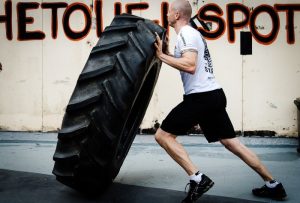
Ever wondered how Olympians bounce back from grueling competitions, or how your favorite pro athlete stays on top of their game? It’s not magic, folks – it’s a carefully orchestrated recovery symphony! From ice baths that feel like polar bear plunges to nutritional strategies that could fuel a small country, we’re diving deep into the world of athletic recovery.
Get ready to ditch the couch potato routine and discover the secrets to maximizing your body’s amazing repair capabilities.
This guide unveils the multifaceted nature of recovery, exploring not just the physical aspects – think strategic rest, active recovery methods, and nutritional power-ups – but also the crucial mental and emotional components. We’ll cover everything from mastering the art of sleep (yes, it’s a skill!) to navigating the mental hurdles that can arise after injury or setbacks. Prepare for a holistic approach that treats your body and mind like the high-performance machines they are.
Physical Recovery Strategies
So, you’ve pushed your body to the limit, conquered that personal best, or maybe just survived another grueling training session. Congratulations! But now comes the equally crucial, and often overlooked, part: recovery. Think of it as the unsung hero of athletic performance – the silent worker that rebuilds, repairs, and ultimately makes you stronger. Without proper recovery, even the most dedicated training regimen will eventually lead to burnout, injury, and a whole lot of grumbling.
The Importance of Rest and Recovery in Athletic Performance
Rest and recovery aren’t just about lounging on the sofa (though that has its place!). They’re fundamental processes that allow your body to adapt to the stresses of training. During rest, your muscles repair microscopic tears sustained during exercise, replenishing glycogen stores and reducing inflammation. Ignoring this vital phase is like trying to build a house without ever letting the cement dry – you’ll end up with a shaky foundation and a potential collapse (in the form of injury or exhaustion).
Adequate rest promotes hormonal balance, improves mood, and enhances cognitive function, all of which are essential for optimal athletic performance. Think of it this way: rest isn’t laziness; it’s strategic recalibration.
Active Recovery Methods
Active recovery involves light physical activity that promotes blood flow and reduces muscle soreness without adding significant stress. It’s like giving your body a gentle nudge back to equilibrium, rather than a full-blown workout. Think of it as a gentle massage for your muscles, not a powerlifting session. Popular methods include:
Light Cardio: A leisurely bike ride, a gentle swim, or a brisk walk are all excellent options. The key is to keep your heart rate elevated but not excessively so. Think conversational pace, not gasping for air.
Stretching: Static stretching (holding a stretch for a period of time) and dynamic stretching (moving through a range of motion) can improve flexibility, reduce muscle stiffness, and enhance recovery. Think yoga, Pilates, or simply taking the time to gently stretch each muscle group.
Incorporating Active and Passive Recovery into a Weekly Training Plan
A sample weekly plan might look like this:
Monday: Intense training session.
Tuesday: Active recovery (light cardio and stretching).
Wednesday: Moderate training session.
Thursday: Passive recovery (foam rolling, self-massage).
Friday: Moderate training session.
Saturday: Long, slow distance training.
Sunday: Complete rest or very light activity like a walk.
This is just a sample, and the ideal balance will depend on the individual athlete’s training volume and intensity. Remember, listen to your body!
Sample Recovery Plan for a Minor Injury
Let’s say you’ve tweaked your ankle. The first step is RICE: Rest, Ice, Compression, Elevation. Then, gradually incorporate gentle range-of-motion exercises to maintain flexibility. Avoid activities that aggravate the injury. As pain subsides, slowly increase activity levels, focusing on active recovery methods like light cycling or swimming.
Professional guidance from a physical therapist or athletic trainer is highly recommended for any injury.
Comparison of Passive Recovery Methods
| Method | Benefits | Drawbacks | Notes |
|---|---|---|---|
| Ice Baths | Reduces inflammation, muscle soreness | Can be uncomfortable, may not be suitable for everyone | Use for 10-15 minutes |
| Foam Rolling | Releases muscle tension, improves flexibility | Can be painful initially, requires proper technique | Focus on tight areas, avoid rolling over joints |
| Massage | Increases blood flow, reduces muscle soreness, improves range of motion | Can be expensive, requires a skilled practitioner | Consider sports massage for athletes |
| Sleep | Essential for muscle repair and hormone regulation | Insufficient sleep can hinder recovery | Aim for 7-9 hours of quality sleep per night |
Nutritional Recovery Strategies
Fueling your body after a workout isn’t just about grabbing the nearest sugary snack; it’s a strategic operation to rebuild, repair, and ultimately, become a stronger, faster, more awesome athlete. Think of it as a high-performance engine needing premium fuel – not just any old gas station swill. Proper nutrition is the key to unlocking your body’s recovery potential and maximizing your training gains.
We’re talking about transforming yourself from a post-workout puddle of exhaustion into a lean, mean, recovery machine!
The Role of Hydration in Athletic Recovery
Hydration is the unsung hero of athletic recovery. Sweating during exercise leads to fluid and electrolyte loss, impacting muscle function and overall performance. Replenishing fluids promptly is crucial. Think of your muscles as thirsty sponges – if they’re dehydrated, they can’t absorb the nutrients needed for repair. Adequate hydration facilitates nutrient transport, helps regulate body temperature, and prevents muscle cramps.
Aim to drink water consistently throughout the day, paying extra attention to fluid intake before, during, and after exercise. Electrolyte drinks can be beneficial, especially after intense or prolonged workouts. Consider the color of your urine; pale yellow is a good indicator of proper hydration.
Macronutrient Balance for Muscle Repair and Recovery
The magic trio of macronutrients – carbohydrates, protein, and fats – play distinct yet interconnected roles in muscle recovery. Carbohydrates replenish glycogen stores depleted during exercise, providing energy for muscle repair and future workouts. Protein is the building block of muscle tissue, crucial for repairing microscopic tears that occur during training. Fats provide sustained energy and support hormone production, essential for overall recovery and growth.
The optimal balance varies depending on the intensity and duration of exercise, but a general guideline is to prioritize carbohydrates and protein post-workout, gradually incorporating healthy fats throughout the day. Think of it as a delicious recovery smoothie – a perfect blend of muscle-building protein, energy-boosting carbs, and healthy fats for sustained energy.
Examples of Post-Workout Recovery Meals and Snacks
Let’s ditch the boring recovery routine! Here are some tasty and effective options:
- Grilled chicken salad with quinoa and mixed greens: A balanced meal with lean protein, complex carbohydrates, and healthy fats.
- Greek yogurt with berries and a sprinkle of granola: Provides protein, carbohydrates, and antioxidants.
- Sweet potato with baked salmon: A powerhouse of carbohydrates, protein, and healthy fats.
- Protein smoothie with fruit and spinach: A quick and easy way to get a dose of protein, carbohydrates, and essential vitamins.
- Hard-boiled eggs with whole-wheat toast: A simple yet effective combination of protein and carbohydrates.
Optimizing Nutrient Timing for Faster Recovery
The “anabolic window,” a period of heightened muscle protein synthesis following exercise, is often discussed. While the exact timing isn’t rigidly defined, consuming carbohydrates and protein within 30-60 minutes post-workout is generally recommended to maximize recovery. This isn’t a strict rule, but rather a guideline; consistency over precise timing is key. Think of it like this: you wouldn’t wait hours to put out a fire; you act quickly.
Similarly, providing your muscles with the building blocks for repair promptly is beneficial. A post-workout snack followed by a larger meal later in the day is an effective strategy.
Foods to Include and Exclude in a Recovery Diet
It’s all about making smart food choices!
- Include: Lean proteins (chicken, fish, beans, lentils), complex carbohydrates (whole grains, fruits, vegetables), healthy fats (avocado, nuts, seeds), fruits rich in antioxidants (berries, cherries).
- Exclude: Processed foods, sugary drinks, excessive saturated and trans fats, alcohol (in excess).
Mental Recovery Strategies

So, you’ve tackled the physical and nutritional aspects of recovery – fantastic! But let’s be honest, the mental game is often the toughest opponent an athlete faces, especially after injury or a major setback. Ignoring the mental side is like trying to build a house on a shaky foundation; it’s just not going to stand the test of time.
This section dives into the crucial mental strategies that will help you not only recover faster but also return to peak performance with renewed vigor (and maybe even a few extra laughs along the way).Common Mental Challenges Faced by Athletes During Recovery PeriodsRecovery isn’t just about mending torn ligaments; it’s also about navigating a rollercoaster of emotions. Athletes often grapple with frustration, anxiety, and even depression during downtime.
The loss of routine, the physical pain, and the uncertainty of their return to competition can create a perfect storm of mental distress. Feelings of helplessness and a loss of identity (“I’m not an athlete if I’m not competing!”) are also common. This isn’t weakness; it’s a completely normal response to a significant disruption in a very important part of your life.
Stress and Anxiety Management Techniques
Effective stress management is paramount during recovery. Progressive muscle relaxation, a technique involving tensing and releasing different muscle groups, can help alleviate physical tension often associated with anxiety. Deep breathing exercises, focusing on slow, controlled breaths, can calm the nervous system and reduce racing thoughts. Cognitive behavioral therapy (CBT) techniques can help athletes identify and challenge negative thought patterns, replacing them with more realistic and positive ones.
For instance, instead of dwelling on “I’ll never be the same,” a CBT approach might encourage reframing the thought to “I’m working hard on my recovery, and I’ll get back to my best, even if it takes time.” Remember, patience is a virtue, especially when dealing with injuries.
Mindfulness and Meditation for Mental Well-being
Mindfulness practices, like meditation, encourage focusing on the present moment without judgment. This can help athletes detach from anxieties about the future or regrets about the past, both of which can significantly hinder recovery. Regular meditation can reduce stress hormones, improve sleep quality, and increase self-awareness, allowing athletes to better recognize and manage their emotional responses to setbacks. Imagine it as giving your brain a much-needed spa day – relaxation, rejuvenation, and a renewed sense of clarity.
Even five minutes a day can make a significant difference.
Visualization Exercises for Enhanced Recovery and Motivation
Visualization, or mental rehearsal, involves vividly imagining successful recovery and return to training. Athletes can mentally practice movements, feel the sensations of their body moving freely, and visualize themselves competing at their best. This mental practice strengthens neural pathways, improving coordination and reducing anxiety related to returning to activity. For example, a basketball player recovering from a knee injury might visualize themselves dribbling, shooting, and making a game-winning shot, focusing on the feeling of strength and agility in their knee.
This isn’t just wishful thinking; it’s a powerful tool for enhancing both physical and mental recovery.
A Combined Mental Recovery Program
A comprehensive mental recovery program might involve a combination of the above techniques. This could include daily mindfulness meditation (10-15 minutes), twice-weekly sessions of progressive muscle relaxation, and regular visualization exercises (at least once a day). It’s also important to schedule time for enjoyable activities unrelated to sports to help maintain a sense of balance and prevent burnout.
Consider activities like spending time in nature, listening to music, reading, or engaging in hobbies. This holistic approach ensures that mental recovery is not an afterthought, but a critical component of the overall healing process. Think of it as your personal recovery playbook – tailor it to your specific needs and preferences for optimal results.
Sleep and Recovery
Ah, sleep. That magical land where your muscles rebuild, your brain defragments, and your grumpy coach magically transforms into a benevolent, cookie-baking fairy. Or, at least, that’s the dream. The reality is that sleep is absolutely crucial for athletic recovery and performance, and skimping on it is like trying to win a marathon on a rusty tricycle.Sleep deprivation throws a serious wrench into the finely-tuned machine that is your athletic body.
It significantly impairs muscle repair, leaving you feeling sore, stiff, and generally like you wrestled a bear (and lost). Furthermore, a lack of sleep weakens your immune system, making you a prime target for those pesky colds and injuries that can sideline even the most dedicated athlete. Think of sleep as the ultimate performance-enhancing drug – completely legal and incredibly effective.
The Impact of Sleep Deprivation on Muscle Repair and Immune Function
Insufficient sleep dramatically hinders the body’s ability to repair and rebuild muscle tissue after intense training. Growth hormone, a key player in muscle growth and recovery, is primarily released during deep sleep. Sleep deprivation reduces growth hormone secretion, slowing down the recovery process and potentially leading to overtraining syndrome. Simultaneously, immune function suffers. Cytokines, proteins that regulate inflammation and fight infection, are produced less efficiently during sleep deprivation, leaving athletes more susceptible to illness.
Imagine trying to run a marathon with a persistent head cold – not exactly ideal. A study published in the
Journal of Applied Physiology* showed a significant correlation between reduced sleep duration and impaired immune response in endurance athletes.
Strategies for Improving Sleep Quality and Duration
Establishing a consistent sleep schedule, even on weekends, is vital. Your body thrives on routine. Aim for 7-9 hours of quality sleep per night. Avoid large meals, caffeine, and alcohol close to bedtime. These substances can interfere with sleep cycles and lead to restless nights.
Regular exercise can improve sleep quality, but avoid intense workouts too close to bedtime. A relaxing evening routine, such as a warm bath or reading a book, can signal to your body that it’s time to wind down. Consider incorporating mindfulness or meditation techniques to reduce stress and improve sleep. One athlete I know swears by counting sheep, although he admits the sheep sometimes start competitive wool-shearing contests in his head, which slightly offsets the relaxation benefits.
Creating a Sleep-Conducive Environment
Your bedroom should be your sanctuary of slumber. Keep it cool, dark, and quiet. Invest in comfortable bedding and consider using blackout curtains or an eye mask to block out light. White noise machines or earplugs can help to muffle disruptive sounds. Ensure your mattress and pillows provide adequate support.
A poorly supportive mattress is like trying to sleep on a pile of rocks – not conducive to restful sleep. Think about the temperature – a slightly cooler room temperature (around 65 degrees Fahrenheit) is generally considered optimal for sleep.
Managing Sleep Disorders that Can Hinder Recovery
Many athletes struggle with sleep disorders like insomnia or sleep apnea, which can significantly impact recovery. If you suspect you have a sleep disorder, it’s crucial to seek professional help. A sleep specialist can diagnose the problem and recommend appropriate treatment options, which might include cognitive behavioral therapy for insomnia (CBT-I), continuous positive airway pressure (CPAP) therapy for sleep apnea, or other interventions.
Ignoring sleep disorders can lead to chronic fatigue, reduced performance, and increased risk of injury. Don’t suffer in silence – seek professional help to get back on track. Remember, prioritizing sleep isn’t just about feeling rested; it’s about optimizing your athletic potential and overall well-being.
Health & Fitness Considerations in Recovery
So, you’ve tackled the nutritional, mental, and sleep aspects of recovery – congrats! But the secret weapon to bouncing back like a superhero (or at least a really fit human) lies in your overall health and fitness. Think of it as building a sturdy house – you can have the fanciest paint and furniture (sleep and nutrition), but if the foundation (overall health) is shaky, the whole thing crumbles.Your body’s recovery speed is a fascinating dance between your athletic training and your general well-being.
A strong, healthy base allows your body to repair and rebuild more efficiently after intense training or injury. It’s like having a team of super-efficient repair elves working overtime instead of a few sluggish apprentices.
Underlying Health Conditions and Recovery
Addressing pre-existing health conditions is paramount for optimal recovery. Untreated conditions, such as diabetes, thyroid issues, or chronic inflammation, can significantly hinder the healing process. Imagine trying to mend a broken fence while battling a swarm of angry wasps – not ideal! Proper management of these conditions, through medication, lifestyle changes, or other interventions, creates a more favorable environment for tissue repair and reduces the risk of complications.
For example, a poorly managed diabetic athlete might experience slower wound healing and increased susceptibility to infections, significantly prolonging their recovery time.
Regular Exercise and Faster Recovery
Don’t mistake “rest” for complete inactivity. Regular, low-impact exercise, outside of your sport-specific training, can surprisingly boost recovery. Think gentle walks, swimming, cycling – activities that promote blood flow and lymphatic drainage without putting excessive stress on injured tissues. This increased circulation helps deliver vital nutrients to injured areas and removes waste products, speeding up the repair process.
Research shows that even light activity can reduce muscle soreness and improve mood, both crucial for a successful recovery.
Maintaining a Healthy Lifestyle During Recovery
Recovery isn’t just about fixing what’s broken; it’s about optimizing your entire system. Prioritize a balanced diet rich in fruits, vegetables, lean proteins, and healthy fats. Hydration is key – think of your body as a finely tuned engine that needs plenty of clean fuel. Manage stress through techniques like meditation or deep breathing exercises. These holistic approaches build resilience and prepare your body for a safe return to training.
Gradual Return to Training After Injury or Illness
Returning to training after a setback requires a carefully planned approach. A rushed return can lead to re-injury or prolonged recovery. Start with low-intensity activities, gradually increasing the duration and intensity as your body adapts. Listen to your body – pain is a warning sign, not a badge of honor. Consult with your physician or physical therapist to develop a personalized plan that considers your specific needs and injury history.
For example, after a hamstring injury, an athlete might start with walking, progress to stationary cycling, and then gradually incorporate light jogging before returning to high-intensity training. This phased approach minimizes the risk of setbacks and ensures a safe and effective return to peak performance.
Monitoring Recovery Progress
So, you’ve diligently followed our advice on physical, nutritional, and mental recovery strategies. You’re sleeping like a baby (or at least, a well-rested athlete), and you’re feeling… well,
- mostly* good. But how do you
- know* you’re actually recovering effectively? This isn’t some mystical guessing game; it’s a science, my friend, and monitoring your progress is key to maximizing your performance and avoiding burnout. Think of it as a performance review, but for your body.
Tracking your recovery isn’t just about numbers; it’s about understanding your body’s signals and making informed decisions. It’s about finding the sweet spot between pushing your limits and preventing injury or exhaustion. Ignoring these vital signs is like navigating a marathon blindfolded – you might get there, but the chances of tripping are significantly higher.
Methods for Tracking Recovery Progress
Several methods exist to monitor your recovery, offering a holistic view of your physical and mental state. These range from sophisticated gadgets to simple self-assessments. Combining various methods provides a richer and more accurate picture than relying on a single metric. For example, a low heart rate variability reading might be complemented by a self-reported feeling of fatigue, painting a clearer picture of your recovery needs.
The Importance of Listening to Your Body and Adjusting the Recovery Plan
This isn’t just some hippy-dippy advice; it’s crucial. Ignoring persistent aches, unusual fatigue, or changes in mood can lead to serious problems. Your body is a complex machine, and it’s constantly sending you signals. Learn to decipher them. If your recovery plan isn’t working, don’t be afraid to tweak it.
Maybe you need more sleep, different nutrition, or a lighter training schedule. Remember, flexibility is key.
Identifying Signs of Overtraining or Under-recovery
Overtraining is like hitting the gas pedal and never letting up. Your body rebels with persistent fatigue, decreased performance, increased resting heart rate, mood swings (think irritability on steroids), and a weakened immune system. You might even find yourself getting sick more often. On the other hand, under-recovery is like trying to run a marathon on an empty tank.
You might feel sluggish, your muscles are constantly sore, and your motivation plummets. Recognizing these signs allows you to adjust your training and recovery strategies proactively.
The Importance of Regular Check-ins with Healthcare Professionals
Regular check-ins with your doctor or physical therapist aren’t just for injuries; they’re essential for preventative care. They can provide personalized guidance, help you interpret your recovery data, and identify potential problems before they escalate. Think of them as your recovery coaches, offering expert advice and keeping you on track.
Interpreting Data from Recovery Monitoring Tools to Optimize Training and Recovery Strategies
Let’s say your heart rate variability (HRV) is consistently low, and your sleep tracker shows you’re getting less than six hours of sleep. This combination suggests you’re likely under-recovered and need to adjust your training volume or intensity. Conversely, if your HRV is high but you still feel fatigued, you might need to examine your nutrition or address underlying mental stress.
Using this data intelligently allows you to fine-tune your training and recovery strategies for optimal performance and well-being. Remember, these tools are just guides; your subjective experience is equally important.
End of Discussion

So, there you have it – a comprehensive playbook for athletic recovery. Remember, recovery isn’t just about patching up after a tough workout; it’s the secret ingredient to consistent peak performance and a long, injury-free athletic career. By understanding and implementing these strategies, you’ll not only enhance your performance but also cultivate a deeper appreciation for your body’s incredible resilience.
Now go forth and conquer (and recover!), champion!
Clarifying Questions
What’s the difference between active and passive recovery?
Active recovery involves light movement like walking or stretching to promote blood flow, while passive recovery focuses on rest and relaxation techniques like massage or ice baths to reduce inflammation.
How much protein should I consume after a workout?
Aim for around 20-30 grams of protein within an hour post-workout to aid muscle repair. The exact amount depends on your individual needs and training intensity.
Is it okay to completely rest after an injury?
Complete rest is sometimes necessary initially, but prolonged inactivity can hinder recovery. Consult a healthcare professional to determine the best approach.
How can I improve my sleep quality for better recovery?
Establish a regular sleep schedule, create a relaxing bedtime routine, ensure a dark and quiet sleep environment, and limit screen time before bed.
What are the signs of overtraining?
Persistent fatigue, decreased performance, mood changes, increased resting heart rate, and persistent muscle soreness can indicate overtraining.





